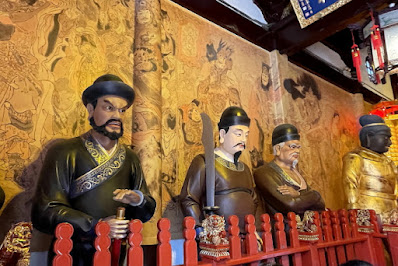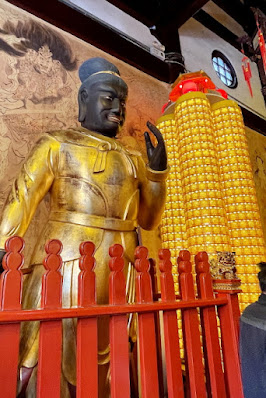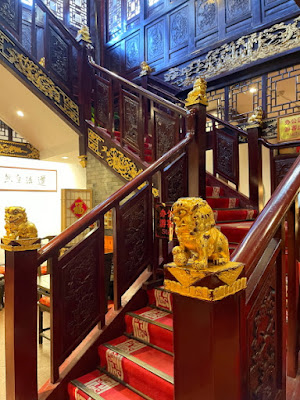It was just a short distance from our hotel to Yu Gardens and Bazaar in China; so rather than take a taxi, it was interesting to just walk and see the changes from the more modern buildings to the historic buildings in Shanghai.
On the same block as our hotel, there was a little shop on the corner that was similar to a US convenience store; but much smaller. And, located outside of the store was a pay phone! Pay phones are no longer placed by convenience stores where we live.
As we were walking we noted large quantities of motor scooters parked on small sidewalk parking lots. I'm not sure where people park that have cars.
 |
| Picture by Kolohe |
 |
| Picture by Kolohe |
 |
| Picture by Kolohe |
 |
| Picture by Kolohe |
 |
| Picture by Kolohe |
 |
| Picture by Heather |
 |
| Picture by Kolohe |
 |
| Picture by Kolohe |
"Old City" Shanghai is a popular place for tourists, so the small shops along the narrow streets open the fronts of their stores to sell goods and services. At the food vender stands, tourists can watch cooks prepare food that is sold across the counter.
At one shop we watched silversmiths at work making fine jewelry and other silver objects. Of course, they had a large display case full of handcrafted items that could be purchased by tourists at what appeared to be inflated prices. We were told that they expect tourists to haggle over prices, so they start high.
 |
| Picture by Heather |
 |
| Picture by Kolohe |
 |
| Picture by Heather |
 |
| Picture by Kolohe |
 |
| Picture by Kolohe |
 |
| Picture by Kolohe |
 |
| Picture by Kolohe |
My favorite shop was the Choc Choco factory where they made all types of things from chocolate -- in addition to chocolate that you could buy and eat, or take home.
In the building's front lobby there was an African animal display and all of the animals were made of chocolate. Even the floor around the animals was covered with chunks of chocolate!
 |
| Picture by Kolohe |
 |
| Picture by Kolohe |
 |
| Picture by Kolohe |
 |
| Picture by Kolohe |
There was an amazing display of artistic items made entirely of chocolate in the main showroom. Even the picture frames were made of chocolate! Details in the crafted works were unbelievable; so each display item was enclosed in a glass case to keep people from touching the delicate exhibits.
 |
| Picture by Kolohe |
 |
| Picture by Kolohe |
 |
| Picture by Kolohe |
While following a self-guided tour route through the building, there was a glass window in front of the factory where visitors could watch chocolates being made. And, of course, the tour ended in a retail store where people could purchase packaged chocolates to take home. For people that were too hungry to wait that long, there was a counter where chocolates could be purchased by the piece. We helped their economy and purchased several different pieces to see which items we thought were the best. It was a hard decision!
On the way out of the building we did a selfie in front of an African jungle scene.
 |
| Picture by Kolohe |
Even the Girl with a Pearl Earring likes Choc Choco.
 |
| Picture by Heather |
 |
| Picture by Kolohe |
A few doors away from the chocolate factory was a store that had a play area where people could pay a fee for their children to come in and play with the animals. It was a great idea because most Chinese homes are small and many families do not have pets.
 |
| Picture by Heather |
The area described as "Yu Gardens" in China tour books is a lot more than just gardens. It is a collection of historic buildings with significant architecture and uses, intermixed with water ponds, rock features, flowers, trees, temples, and shops. In Chinese, the area is called "Chenghuangmiao," which includes Yu Gardens and the area's commercial district. Since foreign tourists can not pronounce "Chenghuangmiao," Chinese guide books just call the entire area "Yu Gardens."
 |
| Picture by Kolohe |
 |
| Picture by Kolohe |
In one courtyard there were street performers and people doing what appeared to be Tai Chi. Now that I look at the pictures again, I don't think they were doing Tai Chi. I think they were doing some type of Buddhist temple ritual because the City God Temple entrance was just behind them.
There was also a man standing on a 2nd floor balcony that was doing magic tricks.
In front of the temple entrance there was a firepit where people were burning incense sticks, Chinese paper money, and Joss Paper. I read that people burn money because they believe it is making advance deposits into an afterlife bank account that the deceased's spirit can access in heaven. Some people also burn money that can be used by deceased relatives.
The Buddhist City God Temple contained several Buddhas and a number of historical items. Within the Temple, bright red Chinese Prayer Ribbons (aka Buddhist Wish Ribbons) can be purchased by visitors to send wishes to Buddha by writing their wishes on the ribbon with a black marker. The ribbons are then left in the Temple. Wishes typically include desires for health, wealth, loved ones, and other items of concern.
 |
| Picture by Kolohe |
 |
| Picture by Kolohe |
 |
| Picture by Kolohe |
 |
| Picture by Kolohe |
 |
| Picture by Kolohe |
 |
| Picture by Kolohe |
The Wan Hua Building contained a collection of cultural relics. One placard that was in English stated that the "Wan Hua Tower...was originally the site of Hua Shen (Goddess of Flower) Tower in the Ming Dynasty."
The Han Bi Tower (Nanmu Carving Tower) derived its name from "The woods have already become red when the water just turns green," a poetic line written by Zhu Xi.










































































No comments:
Post a Comment